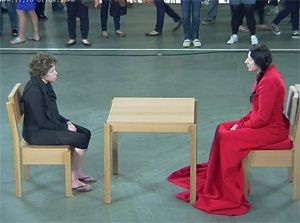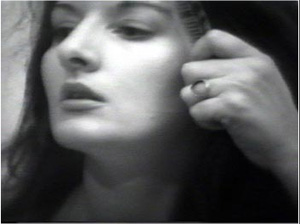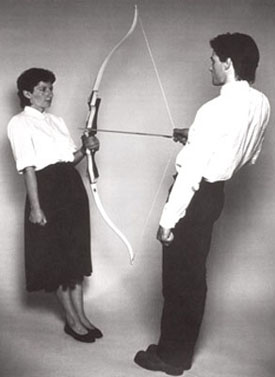The Artist as Museum Piece
John Haberin New York City
Marina Abramovic: The Artist Is Present
Can performance art become a museum piece? Tino Sehgal thinks so. He sells his work to collectors and museums, which pay others to "interpret" it.
Marina Abramovic does him one better. Over four decades, her performances have made viewers passionately and uncomfortably aware of her body and their own. Now she receives a full-scale museum retrospective, including photographs, videos, and half a dozen "live re-performances" by others whom few will remember by name. It culminates in a bare white room, to recreate her last New York gallery performance—but now without a performer. It seems all the emptier for the ladders of butcher knives descending from the shelf where she stood. Oh, and she calls the show "The Artist Is Present." 
Separate reviews consider at greater length her previous New York appearances, in The House with an Ocean View and Balkan Erotic Epic, along with earlier work. A postscript here adds what happens when she descends to product endorsement. For all that, a retrospective allows something new to enter—what happens to performances when Abramovic brings them together. For the show's signature image, she poses holding flowers, like a diva. Something happens when a museum connects the arias.
Present laughter
Forget whether performance art can become a museum piece. It has. But should it? And when it does, is it still performance art? The question may seem trivial, but not everyone will agree on why.
The twentieth century saw one after another assault on the art of museums, and one after another had the public wondering: is that art? And, in no time, museums and the public have absorbed one after another as well. The dilemma can sap past rebellions of their intensity, and the complicity drives too many big-ticket installations and too many vicious circles between dealers and museum directors. Yet it is essential to the continued vitality of art and museums. It may also seem to exclude anything as ephemeral as a performance—or does it?
I want more of Carolee Schneemann than the photo of one naked act, given her career in feminism and performance. I tremble at the thought of more of Chris Burden, besides the locker in which he trapped himself for five days or the glass shards over which he dragged his body. But if I had more, it would no longer be them—at least not when they and performance art were young. In time, it would not be them at all. A near-death experience would have to take into account the brute fact of a human lifespan. If performance could not stop for death, then death would have to kindly stop for the duration of the performance.
Each performance, going back to Allan Kaprow in 1959 and Fluxus in the 1960s, turns on the actor's presence and a moment in time. As their generation had it, art was "happening." It shoves the present right in the face of the audience, for them to respond, and yet the artist refuses to let go. Over time, art takes on other lives in the eyes of others, and art interpretation is a collision between past and present. Performance begs to differ. Forget, it says, the pretensions of art and museums, with art up on a pedestal. Forget, however, taking me the artist down a notch, for it is mine, and in a moment I shall be gone.
This is what makes performance so hard to pull off without my sneering or laughing—which, in the case of Kate Gilmore, is simply the artist's intention. It is scattered, interactive, dangerous, scary, threatening, and funny, which is why it came about in the 1960s. It is also pretentious in its own way. Ironically, to become a museum piece, it has to be still more interactive and more pretentious. Others have to reenact it and experience it. And when they do, has it become instead a collaboration—or a spectacle?
For Tino Sehgal and Marina Abramovic, performance is both, which makes them both intriguing and infuriating. It also makes them obvious candidates for taking performance into museums, and that is just what they have done. Sehgal, of course, took over the Guggenheim for a work "on loan" from another museum. It used a large, changing cast of performers, who spoke personally with each visitor. Still, the artist remained in charge, leading one up and down the ramp. Abramovic lets people find their own way around the Museum of Modern Art, and that makes her retrospective even more of a tribute to her and her command of every moment.
Her life and times
Sehgal accepts the play between the artist's ego and the audience's id. In the Joannou collection at the New Museum, the spectacle and his control are even more obvious. A performer sings every time anyone passes—to the point that I almost begged for silence. However, Sehgal is well aware of what he is doing. The singer, who looks like a museum guard, says so: "This is propaganda. I know, I know."
I know, I know. Sehgal is still in his thirties and having fun, which is why people flock to see him without taking it too seriously. Abramovic puts herself on the line every time, long after Burden retired from his grueling performances. A bare recital of her work packs shock and awe. At the very beginning she was stabbing a knife between her outstretched fingers, again and again and again, knowing that she would sometimes draw blood. In the last decade, with The House with an Ocean View, her facing front on that long, high shelf was mesmerizing.
 Her art also gains power by tracking her life and times. She was young and so was feminism when she jerked a brush through her hair while repeating, "Art must be beautiful. The artist must be beautiful." The retrospective's first room also sets out tools with which her audience once choose to attack or defend her. Frightening as they are, they parallel the scissors that Yoko Ono once offered in her Cut Piece, so that others could snip away at her clothing.
Her art also gains power by tracking her life and times. She was young and so was feminism when she jerked a brush through her hair while repeating, "Art must be beautiful. The artist must be beautiful." The retrospective's first room also sets out tools with which her audience once choose to attack or defend her. Frightening as they are, they parallel the scissors that Yoko Ono once offered in her Cut Piece, so that others could snip away at her clothing.
In 1976 she met Frank Uwe Laysiepen, the German artist known as Ulay. With Imponderabilia in 1977, people could squeeze through a doorway narrowed by her and a man's naked body. Their subsequent retreat to an Asian monastery recalls the counterculture, and their walk the length of the Great Wall turned into a history of their twelve-year partnership all by itself. They planned to meet in the middle, in celebration of marriage. By the time they got permission from the Chinese government, they had decided to part, and their passing on the wall had become a farewell. With The House with an Ocean View in 2002, an older artist alone accepts the public eye.
In the late 1990s, Abramovic turns to her origins and to the Bosnian War, but without the physical pain and political outrage of Carlos Martiel caught between Cuba and America. Born in Belgrade in 1946, she had not often looked back. With Balkan Baroque in 1997, though, she scraped away at animal bones, cleaning them of skin and flesh. The gory process speaks of horror and futility, and so do the bare white bones at MoMA. Her video Balkan Erotic Epic in 2005 sums up her themes of rituals, native customs, and sex. It also is her first attempt to involve a large, anonymous cast.
Abramovic sits each day at MoMA with the retrospective's title piece. The Artist Is Present is both a reenactment and a passing of her work to others. In Nightsea Crossing, restaged in several countries between 1981 and 1987, she and Ulay faced each other across a small table with no movement or trace of emotion. This time she invites anyone to sit across from her, for as long as anyone likes. Its engagement with the atrium already announces her entrance into the museum. It also announces what that entrance costs the work of art.
Performance as spectacle
In the vastness of MoMA's atrium, a large square isolates Abramovic from her audience. Potential participants wait on line for as much as five hours at a time. Even so, no one can match her endurance, her flowing dress, and her lack of expression, not to mention her survival without obvious trips to the bathroom. Performance has become interactive, but not a collaboration among equals. Cameras and lights allow anyone to watch online, in real time, but they also convert the site into a stage set, with the artist as star. The society of the spectacle has begun.
Upstairs in the gallery for temporary exhibitions, the transformation is almost complete, while large photographs and a "Personal Archaeology" at her Chelsea gallery do their best to announce her deification. Not fully complete, because this artist still commands attention, and so much is going on. However, as The New York Times notes, "few MoMA visitors seem upset" (although some, it later reported, were caught groping). They squeeze awkwardly but happily past two nudes, but the passage between them is wider than in 1977, in accord with museum standards. Then, too, these are gallery walls, with the passage created specifically for exhibitions—and an alternative passage for the squeamish not far away. The simultaneity of performances further converts the galleries into a carnival.
The exhibition credits all performers, but where Sehgal calls his cast interpreters, these figures have no leeway in following the script. Their anonymity works against them as well, draining gestures of their associations with sex and death. Of course, they rest immobile, like the man with a skeleton weighing down on his chest. More than once, they are also set into the partitions, like the couple back to back with their hair braided together. The show has framed them, like art objects. The immobility of endurance is now the timelessness of a museum's permanent display. 
Perhaps the transformation began long ago, as part of the artist's career. That first room has the look of a crime scene, and her cries and hesitation still ring out as she brushes her air. In collaboration with Ulay, bloodshed gives way to something less overt and more showy but just as memorable. Tension courses through their encounters, like the physical tension in the bow and arrow aimed at her heart in Rest Energy. By the time of The House with an Ocean View, I was questioning my own admiration, although it would not go away. Standing erect, with a telescope on the floor pointing to her rather than a bow, Abramovic was already playing both art object and spectacle.
Three years later, I found the Balkan Erotic Epic pretty silly. She was mocking sex as a commodity, but with a very straight face, as if laughter were out of place. She was also insisting on a point of origins, another way of putting herself on stage and another association of art with a timeless ritual. She had also embraced the idea of reenactment. For the Guggenheim that same year, she performed five past works by others. In more than one way, she and performance had entered the museum.
Abramovic seizes the moment to shape her place in the past. On the eve of the show, a New Yorker article with her cooperation cites her antecedents in life-threatening feats, but not in chaotic happenings or women performers. It describes her walk on the Great Wall solely as a farewell, as if she and Ulay had planned that all along. Every retrospective reinvents a career and asserts its place in history, and Abramovic deserves one more than any performance artist going. The fascinating question is whether that place will be as performance art.
A postscript: just desserts
Maybe the art world is getting its just desserts. Anyone willing to pay often does. And now we know who gets a share of the profits. And it is not Larry Gagosian or Jeffrey Deitch.
Marina Abramovic has shocked me, riveted me, moved me, bored me, and thoroughly annoyed me. Now she is aiming at a classier crowd. Her recipe for chocolate ice cream served in meringue, The New York Times reports now caps off a meal at Park Avenue Winter on the Upper East Side. Not that she prepares it for diners personally. Not that she appears in performance to serve it either, but the article's photograph helps one imagine what it would be like if she did. Remember, too, to imagine taking revenge by spraying her with Cool Whip.
Just to be clear, dessert apparently comes with her book of recipes and an mp3 talk by the artist herself. "You receive this dessert in front of you," the article quotes her this morning as saying, "and it's kind of a mystery." So is how she reached this point. Was it desperation or grandiosity? And will Ulay get a taste? Next time they walk the Great Wall of China together, I hope they remember to sprinkle the peasants with chocolate cookie crumbs and spun sugar.
Her MoMA retrospective put Abramovic at its center, along with the weaknesses of both the artist and the atrium. Upstairs, performances fell to other, younger bodies and new museumgoers, in reenactment. Like Tino Sehgal around the same time, she raised reasonable questions about what happens when performance art enters a museum. Can the work be preserved for the future? Can its impulse or its terror? The outcome suggests strongly that, paradoxically, she was putting herself and her stardom ahead of the work all along.
Now Abramovic takes more or less the reverse tack: rather than absenting herself from her own work, she inserts herself as a treat. In fact, as dessert. A post-structuralist might call this the "logic of the supplement." I think that means a reminder to tip generously. Let me get some strong coffee. Black.
The artist's signature becomes the mark not of historic preservation but product endorsement. Such is the transition from creativity to celebrity, and it dogged plenty of big shows in the last year. The idea of restaurant manager or chef as performer has colored the dining scene as well. It should not, however, dominate discussion of the arts. There are plenty of others working in new and traditional media, and no amount of resentment at celebrity will bury them or justify them all by itself. Enough dark chocolate might, though.

Marina Abramovic's "The Artist Is Present" ran at The Museum of Modern Art through May 31, 2010, while additional materials ran at Sean Kelly through June 19. Related reviews look at "The House with an Ocean View," "Balkan Exotic Epic," and other works. The article in The New York Times appeared with a luscious photograph in the Dining section for January 12, 2011.




